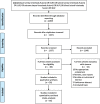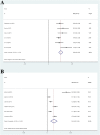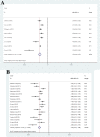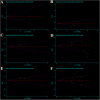Differences in radiographic and clinical outcomes of oblique lateral interbody fusion and lateral lumbar interbody fusion for degenerative lumbar disease: a meta-analysis
- PMID: 31801508
- PMCID: PMC6894220
- DOI: 10.1186/s12891-019-2972-7
Differences in radiographic and clinical outcomes of oblique lateral interbody fusion and lateral lumbar interbody fusion for degenerative lumbar disease: a meta-analysis
Abstract
Background: In the current surgical therapeutic regimen for the degenerative lumbar disease, both oblique lateral interbody fusion (OLIF) and lateral lumbar interbody fusion (LLIF) are gradually accepted. Thus, the objective of this study is to compare the radiographic and clinical outcomes of OLIF and LLIF for the degenerative lumbar disease.
Methods: We conducted an exhaustive literature search of MEDLINE, EMBASE, and the Cochrane Library to find the relevant studies about OLIF and LLIF for the degenerative lumbar disease. Random-effects model was performed to pool the outcomes about disc height (DH), fusion, operative blood loss, operative time, length of hospital stays, complications, visual analog scale (VAS), and Oswestry disability index (ODI).
Results: 56 studies were included in this study. The two groups of patients had similar changes in terms of DH, operative blood loss, operative time, hospital stay and the fusion rate (over 90%). The OLIF group showed slightly better VAS and ODI scores improvement. The incidence of perioperative complications of OLIF and LLIF was 26.7 and 27.8% respectively. Higher rates of nerve injury and psoas weakness (21.2%) were reported for LLIF, while higher rates of cage subsidence (5.1%), endplate damage (5.2%) and vascular injury (1.7%) were reported for OLIF.
Conclusions: The two groups are similar in terms of radiographic outcomes, operative blood loss, operative time and the length of hospital stay. The OLIF group shows advantages in VAS and ODI scores improvement. Though the incidence of perioperative complications of OLIF and LLIF is similar, the incidence of main complications is significantly different.
Keywords: DLIF; Degenerative lumbar disease; LLIF; OLIF; XLIF.
Conflict of interest statement
The authors declare that they have no competing interests.
Figures





References
-
- Ohtori S, Orita S, Yamauchi K, Eguchi Y, Ochiai N, Kishida S, Kuniyoshi K, Aoki Y, Nakamura J, Ishikawa T, et al. Mini-open anterior retroperitoneal lumbar Interbody fusion: oblique lateral Interbody fusion for lumbar spinal degeneration disease. Yonsei Med J. 2015;56(4):1051–1059. doi: 10.3349/ymj.2015.56.4.1051. - DOI - PMC - PubMed
Publication types
MeSH terms
Grants and funding
LinkOut - more resources
Full Text Sources
Medical

